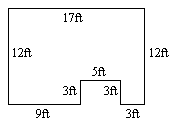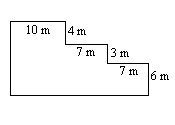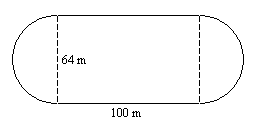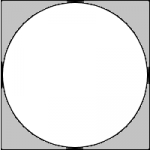1.20: Composite Figures
- Page ID
- 56859

You may use a calculator throughout this module as needed.
Many objects have odd shapes made up of simpler shapes. A composite figure is a geometric figure which is formed by—or composed of—two or more basic geometric figures. We will look at a handful of fairly simple examples, but this concept can of course be extended to much more complicated figures.
To find the area of a composite figure, it is generally a good idea to divide it into simpler shapes and either add or subtract their areas as necessary.
A floor plan of a room is shown. The room is a \(12\)-foot by \(17\)-foot rectangle, with a \(3\)-foot by \(5\)-foot rectangle cut out of the south side.

1. Determine the amount of molding required to go around the perimeter of the room.
2. Determine the amount of flooring required to cover the entire area.
- Answer
-
1. \(64\text{ ft}\)
2. \(189\text{ ft}^2\)
You may need to figure out some unmarked dimensions.
A plan for an irregular parking lot is shown.

3. Calculate the perimeter.
4. Calculate the area.
- Answer
-
3. \(74\text{ m}\)
4. \(235\text{ m}^2\)
Sometimes, composite figures involve parts of circles coupled with polygons.
A high school is building a track at its athletic fields. The track, which is formed by two straight sides and two semicircles as shown in the plans below, is supposed to have a total length of \(400\) meters.

5. Determine the distance around the track. Will the track be the right length?
6. After the new track is built, landscapers need to lay sod on the field inside the track. What is the area of the field inside the track?
- Answer
-
5. Based on the stated measurements, the distance around the track will be 401 meters, which appears to be 1 meter too long. In real life, precision would be very important here, and you might ask for the measurements to be given to the nearest tenth of a meter.
6. around \(9,620\text{ m}^2\)
If we need to determine a fraction or percent out of the whole, we may be able to solve the problem without knowing any actual measurements.

7. Circular disks are being cut from squares of sheet metal, with the remainder around the corners being discarded. Assuming that the circles are made as large as possible, what percent of the sheet metal will be discarded?
- Answer
-
around \(21.5\%\) (Hint: Make up an easy number for the side of the square, like 2 or 10.)


